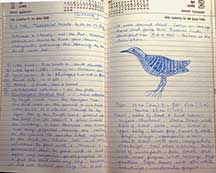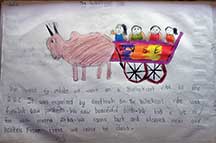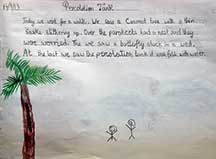V Santharam
Having introduced students to nature and the outdoors, how can we ensure that their interest in their surroundings and their inhabitants is kept alive?
 One of the ways in which one can sustain the interests of children in Nature is by maintaining a nature journal. A nature journal is a personalized record of one’s observations – of things one notices during various field trips and walks or even by just looking out of a window in our own garden. Apart from merely documenting observations, a nature journal could include thoughts and reflections about the various things one observes or feels. This is an ideal medium to gather and reflect one’s views pertaining to various aspects of natural history. A nature journal helps one to strengthen the powers of observation, describe their observations as accurately as possible and draw inferences from these observations.
One of the ways in which one can sustain the interests of children in Nature is by maintaining a nature journal. A nature journal is a personalized record of one’s observations – of things one notices during various field trips and walks or even by just looking out of a window in our own garden. Apart from merely documenting observations, a nature journal could include thoughts and reflections about the various things one observes or feels. This is an ideal medium to gather and reflect one’s views pertaining to various aspects of natural history. A nature journal helps one to strengthen the powers of observation, describe their observations as accurately as possible and draw inferences from these observations.
One realizes the value of a nature journal when one goes through one’s entries after a gap of time. This helps refresh pleasant memories and remember various events in nature that had been forgotten. These entries can also serve as a documentation of various natural history events over the years and can help in comparing past events with present day occurrences such as dates of flowering of a tree or the arrival or departures of various migrant species in a locality. This sort of information helps us to piece together observations over the years to better understand the impact of global warming and the responses it evokes among various species of plants and animals.
There is no specific format for a nature journal. One can adapt it to suit one’s own requirements. What is basically necessary is a notebook and a pen. When required, one could add drawings and sketches to supplement one’s notes. These could be mere line drawings or colour sketches or even paintings. Photographs could be added when available. Incorporating specimens of pressed leaves or flowers or bark rubbings could further enhance the journal’s value.
 The writing itself could be in the prose format, or in verse, or a combination of both. Rather than writing self-consciously, taking into account grammatical niceties, a nature journal should be spontaneous and have candid writing, reflecting one’s moods and feelings.
The writing itself could be in the prose format, or in verse, or a combination of both. Rather than writing self-consciously, taking into account grammatical niceties, a nature journal should be spontaneous and have candid writing, reflecting one’s moods and feelings.
Apart from all the observations made, the journal entries should include the date, time of day, notes on weather conditions, and the habitat in which the observations were made. Names of others present on the occasion could help as at a later date this could be useful to crosscheck some facts or details you may have missed out at the time of writing the journal. Ideally, the journal entries should be made in the field or before the end of the day when the memories or experiences are still fresh. It can be difficult for us to recollect events in the same detail even after a few hours and so the earlier the entry is made, the better.
To help one write good journal notes, it is essential that the important details are noted before they fade from memory and here a field notebook can come in handy. This could be any small notebook that can easily fit in one’s pocket, where quick jottings could be made whenever needed. These entries could form the basis for more detailed journal entries later that day.
Among the side benefits of writing a journal is that it can help in improving skills – drawing and sketching, writing including those pertaining to language and creative writing, and scientific thinking.
 Nature journals have in the past been popular with great scientists and naturalists. Indeed the most famous of them all is the “The Voyage of the Beagle” by Charles Darwin (1809-1882), which was an account of his travel that was the precursor to the discovery of the evolutionary theory. Henry David Thoreau (1817 – 1862) was a famous American naturalist, author, philosopher, and original thinker. His journals run into 47 manuscript volumes and contain besides other things, natural history records of his native Massachusetts. Based on his journal entries, scientists are now discovering how the native plants and birds are responding to global warming. Yet another famous personality is Gilbert White (1720-1793), an English parson-naturalist, whose famous book, “The Natural History and antiquities of Selbourne” (1789), being a collection of his writings on natural history in the letter format, has the distinction of being in print ever since it was first published. We have several naturalists in India who have also maintained nature journals – Dr Salim Ali, the well-known ornithologist, being one such meticulous chronicler.
Nature journals have in the past been popular with great scientists and naturalists. Indeed the most famous of them all is the “The Voyage of the Beagle” by Charles Darwin (1809-1882), which was an account of his travel that was the precursor to the discovery of the evolutionary theory. Henry David Thoreau (1817 – 1862) was a famous American naturalist, author, philosopher, and original thinker. His journals run into 47 manuscript volumes and contain besides other things, natural history records of his native Massachusetts. Based on his journal entries, scientists are now discovering how the native plants and birds are responding to global warming. Yet another famous personality is Gilbert White (1720-1793), an English parson-naturalist, whose famous book, “The Natural History and antiquities of Selbourne” (1789), being a collection of his writings on natural history in the letter format, has the distinction of being in print ever since it was first published. We have several naturalists in India who have also maintained nature journals – Dr Salim Ali, the well-known ornithologist, being one such meticulous chronicler.
On a personal note, I have been maintaining notebooks where I have been jotting down my observations on birds since 1978. I have notes on birds and other interesting aspects of nature written chronologically over these few decades. I have included rough sketches of birds when I see a new species and mark their colours and shapes and note down various aspects of their behaviour and ecology. Occasionally, I also include sketch maps of the locality visited for future reference.
Based on these notes, I can crosscheck species records or behaviour over the years and across several localities. I can generate a checklist of birds of any area I have been to and can also see what kind of habitat changes have taken place over the years and what impact they have on the bird compositions of various localities I studied. I can also draw inferences on changes in migration dates over the years and see if there are any deviations. I can also study the status of various birds and see if their populations are on the increase or decline. I can compare my current bird list with the list of birds seen two decades ago to see if there are any major changes in the species compositions over the years. The data stored in my journals help me write articles and papers for magazines and natural history journals.
Apart from all these, flipping through my journal brings back to my mind vivid memories of the past and helps re-live some of the exciting and interesting moments, years later.
The author is with the Institute of Bird Studies and Natural History, Rishi Valley Educational Centre, Chittoor, Andhra Pradesh. He can be reached at santharam.v@gmail.com.
